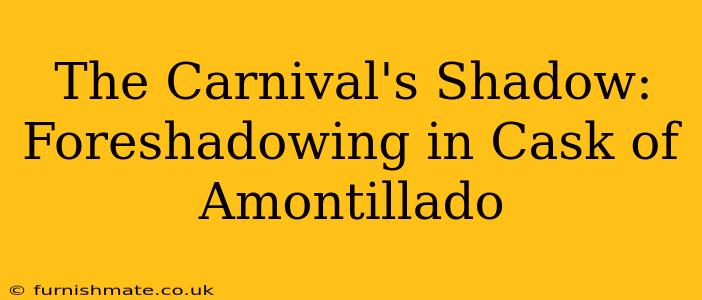Edgar Allan Poe's "The Cask of Amontillado" is a masterclass in suspense, a chilling tale of revenge meticulously plotted and executed. While the story's shocking climax leaves a lasting impact, its power is amplified by Poe's masterful use of foreshadowing. The seemingly innocent details subtly hint at the gruesome events to come, creating a palpable sense of dread that grips the reader from the very beginning. This exploration will delve into the key instances of foreshadowing, revealing how Poe expertly crafts a narrative of escalating tension.
The Setting: A Carnival of Deceit
The story opens during carnival season, a time of revelry and disguise. This setting itself acts as a powerful foreshadowing device. The festive atmosphere, filled with masks and anonymity, provides the perfect cover for Montresor's sinister plan. The chaotic energy of the carnival mirrors the chaos Montresor intends to unleash upon Fortunato. This initial setting foreshadows the deception and hidden malice that will dominate the narrative.
How does the carnival setting foreshadow the events of the story?
The carnival's atmosphere of masked identities and hidden intentions directly reflects Montresor's own duplicity. He uses the guise of friendship and generosity to lure Fortunato into his deadly trap. The festive chaos provides a screen for his murderous intent, allowing him to act without immediate suspicion. The celebratory mood contrasts sharply with the impending violence, heightening the sense of impending doom.
The "Amontillado" Itself: A Bait and a Symbol
The promise of rare Amontillado wine serves as a crucial piece of foreshadowing. Fortunato's weakness for this prized vintage is expertly exploited by Montresor. The allure of the wine acts as bait, drawing Fortunato deeper into the catacombs, ultimately to his doom. The Amontillado, therefore, becomes a symbol of Fortunato's pride and his eventual downfall.
Is the Amontillado merely a lure, or does it symbolize something deeper?
The Amontillado transcends its role as mere bait. It symbolizes Fortunato's pride and his susceptibility to flattery, both of which Montresor skillfully manipulates. The wine, a coveted prize, represents the things Fortunato values most, ultimately becoming the instrument of his destruction. It’s a powerful metaphor for the intoxicating nature of vanity and how easily it can lead to one’s ruin.
Ominous Words and Actions: Montresor's Subtle Hints
Throughout the story, Montresor drops subtle hints and employs suggestive language that foreshadows his deadly intentions. His repeated emphasis on his family motto, "Nemo me impune lacessit" ("No one attacks me with impunity"), subtly warns the reader of his unwavering commitment to revenge. His seemingly polite demeanor masks a chilling ruthlessness, foreshadowing the brutal act to come.
What other subtle clues does Montresor give away?
Beyond the motto, Montresor's actions speak volumes. His insistence on leading Fortunato deeper into the catacombs, despite Fortunato's increasing discomfort and the damp conditions, clearly foreshadows a dangerous outcome. His calm demeanor amidst the chilling atmosphere and his manipulation of Fortunato’s pride are further indications of his premeditated actions. Every seemingly innocuous action contributes to the growing sense of foreboding.
The Catacombs: A Tomb in Waiting
The setting of the catacombs themselves serves as a powerful symbol of death and entrapment. The dark, damp, and claustrophobic environment foreshadows Fortunato's fate. The very architecture of the place, with its tombs and bones, serves as a constant reminder of mortality and the impending doom awaiting Fortunato.
How does the setting of the catacombs contribute to the foreshadowing?
The catacombs are not just a location; they are a visual representation of the story’s outcome. The labyrinthine structure mirrors the complexity of Montresor's plan, while the presence of the dead foreshadows Fortunato’s imminent demise. The dampness and chill mirror the coldness of Montresor's heart, and the overall atmosphere of decay underlines the irreversible nature of his act.
Conclusion: A Symphony of Foreshadowing
Poe’s masterful use of foreshadowing in "The Cask of Amontillado" elevates the story from a simple tale of revenge to a chilling exploration of human nature. By weaving subtle hints throughout the narrative, Poe builds a palpable sense of dread, leaving the reader both horrified and fascinated by the intricate web of deception and violence. The carnival’s festive facade, the tempting Amontillado, Montresor’s ominous words, and the suffocating atmosphere of the catacombs all work in concert to create a narrative masterpiece that remains deeply disturbing and powerfully effective.

